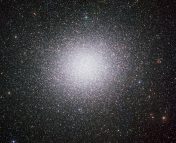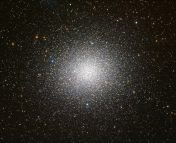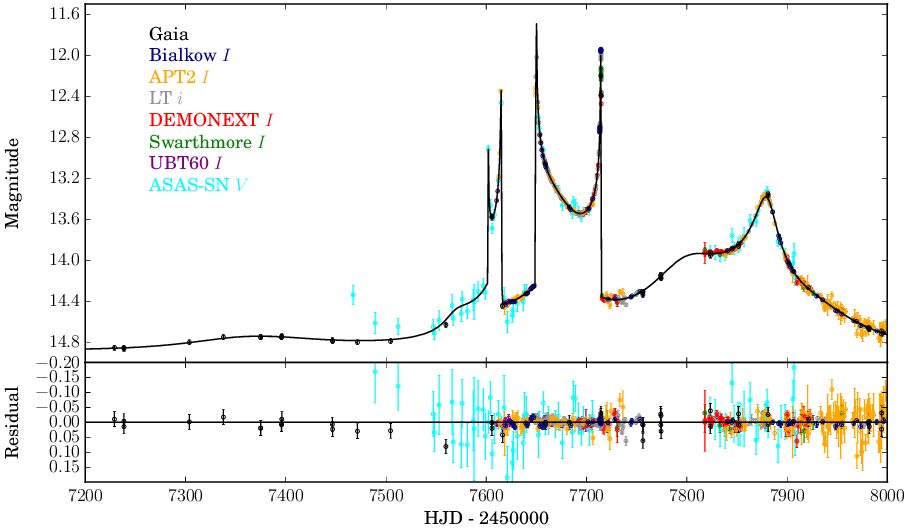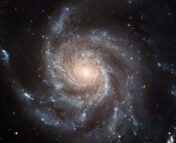Title: GaiaHub: A method for combining data from the Gaia and Hubble space telescopes to derive improved proper motions for faint stars
Authors: Andrés del Pino, Mattia Libralato, Roeland P. van der Marel, Paul Bennet, Mark A. Fardal, Jay Anderson, Andrea Bellini, Sangmo Tony Sohn, Laura L. Watkins
First Author’s Institution: 1. Centro de Estudios de Física del Cosmos de Aragón (CEFCA), Unidad Asociada al CSIC, Plaza San Juan 1, 44001, Teruel, Spain 2. Space Telescope Science Institute, 3700 San Martin Drive, Baltimore, MD 21218, USA
Status: Accepted to ApJ [open access]
Intro: What is proper motion and how to find it
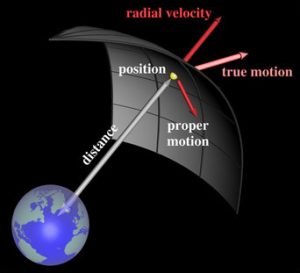
Stars in the night sky seem fixed, but they are all traveling through the Milky Way just like the Sun. Since objects in the universe travel in 3D space, we can separate their velocities into three components: the radial velocity, which points towards or away from the Earth, and proper motion, which is in the plane of the sky. Radial velocity is usually measured by finding the redshift of the object’s spectral lines, and it can reach down to several kilometers per second in accuracy. Proper motion is much harder to measure.
The measurement of accurate sky positions is called astrometry. Proper motion measurement relies on astrometry, since we are comparing observations from two epochs and calculating how much the position of the star changed. This is the strong suit of the Gaia mission, which probes stars out to the halo of the Milky Way galaxy (see this astrobite). Gaia has led to many discoveries: new globular clusters in the Milky Way, stars moving so fast enough to escape the Milky Way, groups of stars that move together, and there’s plenty more to come.
However, Gaia data have two important shortcomings. Firstly, it is a small telescope and works better for bright stars. For faint stars, the astrometric errors rise rapidly. But if we are interested in a faraway system (e.g. a satellite dwarf galaxy of the Milky Way), all the stars will be faint. Using Gaia data alone, the velocity errors far exceed the true variation in the galaxy. The second issue is the time baseline. Given a constant velocity, stars will shift more if you wait longer between two observations. That is why the time baseline has a huge impact on proper motion accuracy. Gaia has only been operating and recording positions for three years. If there is a way to increase the time baseline, that can also improve the proper motion measurements.
How to measure proper motions better?
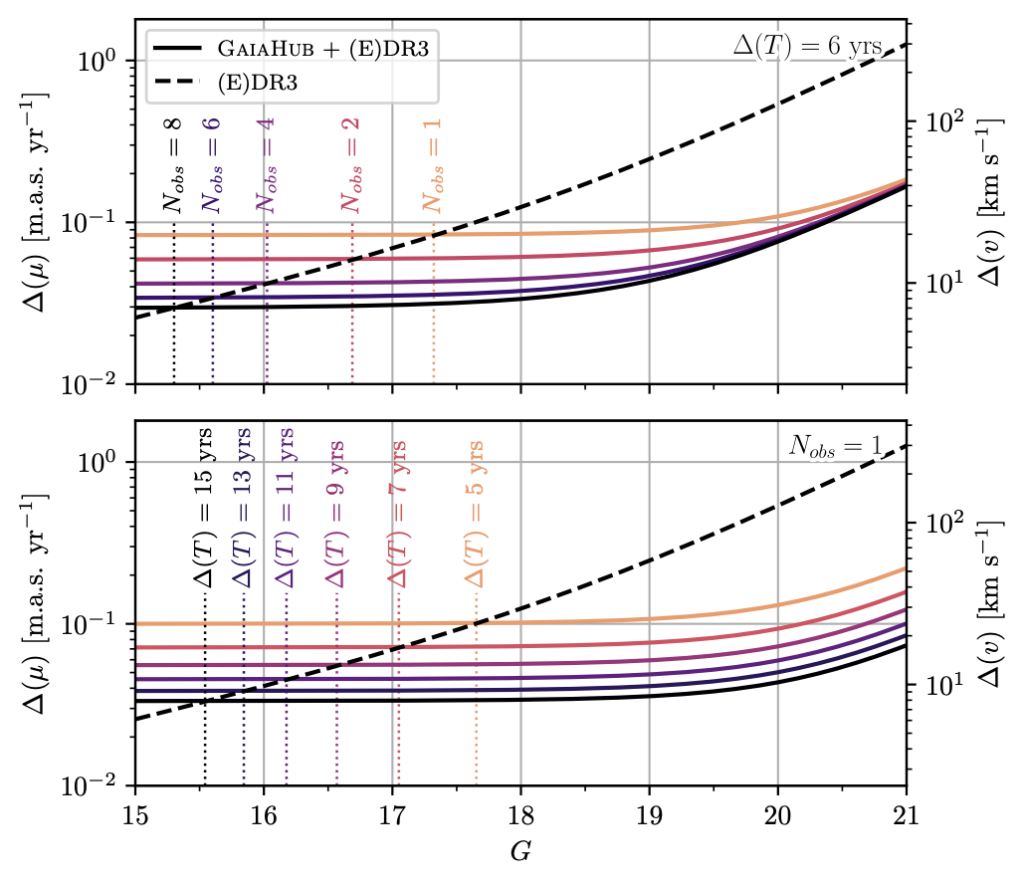
Prior to the launch of the Gaia space telescope, the workhorse in astrometry studies was the Hubble Space Telescope. Hubble data can solve both of the issues mentioned above. It can observe much fainter stars, and it’s been taking data 10-15 years before Gaia was even launched. If there is a way to combine these datasets, the time baseline for the proper motion measurements could be extended by a factor of 4-6. As shown in Fig. 2, even adding one HST image can push down the errors by a lot for faint stars (G > 17). That is precisely what the authors in today’s paper will do.
Combining HST and Gaia
The authors of today’s paper developed a software called GaiaHub, which will compare the positions of the stars measured with Gaia with those measured with HST. The first step is to measure positions of stars in HST data. This is a well-established process that takes into account the instrument distortions and time variations, and achieves a typical accuracy of 0.25 – 0.5 milliarcseconds.
Then comes the hard part: the star positions need to be matched to Gaia measurements. Since the two datasets are more than 10 years apart, establishing a common reference frame between the two is the key challenge. The software offers three different algorithms: when there is a large number of randomly moving stars, it matches the average positions of all stars; when the stars have some coherent motion, the proper motion can be modeled iteratively so that the coherent motion is removed. Finally, if there are many contaminant stars, the code can also set up the reference frame from co-moving stars. The improved accuracy with Gaia+HST data can be seen in Fig. 1, as a function of the magnitude of the stars.
Results
So how does this software perform on real data? Fig. 3 shows the drastic improvement you get from combining Gaia and Hubble data. In this example, proper motions are used to identify member stars of a globular cluster Pal 4. The stars in a cluster should move together, which means they should all have similar proper motions. The left column in Fig. 3 shows the proper motion in RA and Dec, measured by Gaia alone (top panel) and GaiaHub (bottom panel). The proper motion measurements from GaiaHub clearly have much smaller scatter and allow for a cleaner selection of member stars. This is confirmed by the right column, which shows the sky positions of the selected stars and their proper motion vectors. In the Gaia selection, the lines indicating the direction of motion point all over the place, while GaiaHub results show very coherent motion. Given that member stars should move together, GaiaHub successfully picks out the likely members of Pal 4.
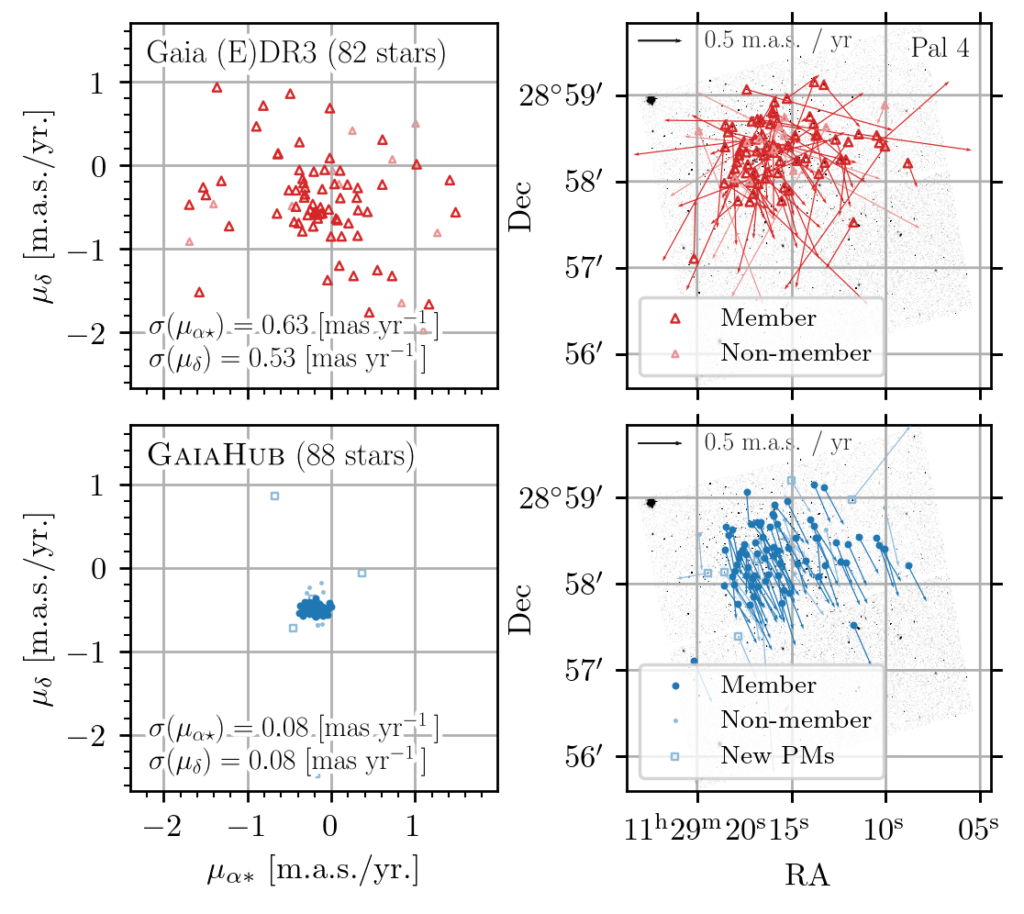
This is a huge improvement for proper motion measurements! Large uncertainties in proper motion means that we get more scatter in the velocities, and that leads to artificially large velocity dispersion measurements for globular clusters. With GaiaHub’s new capabilities, the artificial scatter is reduced and we can recover the real internal velocity dispersions. The authors did this exercise for 40 globular clusters and published their results in this paper. Along with radial velocities, we now have the full 3D velocity information. GaiaHub opens exciting new science analyzing velocity dispersions along each direction.
As with all research techniques, GaiaHub has its limitations. Due to the cross matching, GaiaHub relies on stars that overlap in both datasets. That means the field of view is limited by the smaller of the two, which is Hubble. The magnitude of the stars that can be detected by both telescopes is also a limited range, since bright stars are often saturated in Hubble images. Both of these factors mean that GaiaHub works best at an intermediate distance, where the Hubble field of view is large enough to cover the globular cluster and the brightest stars are faint enough to not be saturated.
To summarize, GaiaHub improves the proper motion measurements by a factor of ten. More precise proper motions at fainter magnitudes allows us to study the kinematics of many stellar systems around the Milky Way. This public software will be a great resource for the astronomy community!
Astrobite edited by Katya Gozman
Featured image credit: Zili Shen

